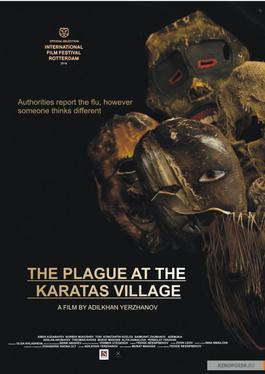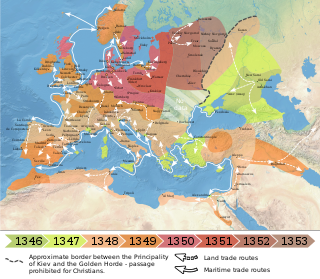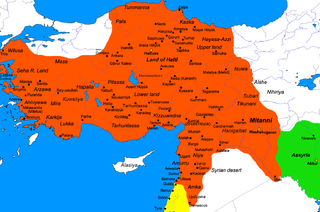Related Research Articles

Plague is an infectious disease caused by the bacterium Yersinia pestis. Symptoms include fever, weakness and headache. Usually this begins one to seven days after exposure. There are three forms of plague, each affecting a different part of the body and causing associated symptoms. Pneumonic plague infects the lungs, causing shortness of breath, coughing and chest pain; bubonic plague affects the lymph nodes, making them swell; and septicemic plague infects the blood and can cause tissues to turn black and die.

A quarantine is a restriction on the movement of people, animals, and goods which is intended to prevent the spread of disease or pests. It is often used in connection to disease and illness, preventing the movement of those who may have been exposed to a communicable disease, yet do not have a confirmed medical diagnosis. It is distinct from medical isolation, in which those confirmed to be infected with a communicable disease are isolated from the healthy population.

Septicemic plague is one of the three forms of plague, and is caused by Yersinia pestis, a gram-negative species of bacterium. Septicemic plague is a systemic disease involving infection of the blood and is most commonly spread by bites from infected fleas. Septicemic plague can cause disseminated intravascular coagulation and is always fatal when untreated. The other varieties of the plague are bubonic plague and pneumonic plague.

Our Lady of Ljeviš is a 14th-century Serbian Orthodox church in the town of Prizren, in southern Kosovo. Since 2006, the church is part of the UNESCO World Heritage Site named Medieval Monuments in Kosovo.

A plague doctor was a physician who treated victims of bubonic plague during epidemics in 17th-century Europe. These physicians were hired by cities to treat infected patients regardless of income, especially the poor, who could not afford to pay.

The third plague pandemic was a major bubonic plague pandemic that began in Yunnan, China, in 1855. This episode of bubonic plague spread to all inhabited continents, and ultimately led to more than 12 million deaths in India and China, and at least 10 million Indians were killed in British Raj India alone, making it one of the deadliest pandemics in history. According to the World Health Organization, the pandemic was considered active until 1960, when worldwide casualties dropped to 200 per year. Plague deaths have continued at a lower level for every year since.

The Great Plague of Marseille, also known as the Plague of Provence, was the last major outbreak of bubonic plague in Western Europe. Arriving in Marseille, France, in 1720, the disease killed over 100,000 people: 50,000 in the city during the next two years and another 50,000 to the north in surrounding provinces and towns.

Bubonic plague is one of three types of plague caused by the bacterium Yersinia pestis. One to seven days after exposure to the bacteria, flu-like symptoms develop. These symptoms include fever, headaches, and vomiting, as well as swollen and painful lymph nodes occurring in the area closest to where the bacteria entered the skin. Acral necrosis, the dark discoloration of skin, is another symptom. Occasionally, swollen lymph nodes, known as "buboes", may break open.
Cuma or CUMA may refer to:

The second plague pandemic was a major series of epidemics of plague that started with the Black Death, which reached medieval Europe in 1346 and killed up to half of the population of Eurasia in the next four years. It followed the first plague pandemic that began in the 6th century with the Plague of Justinian, but had ended in the 8th century. Although the plague died out in most places after 1353, it became endemic and recurred regularly. A series of major epidemics occurred in the late 17th century, and the disease recurred in some places until the late 18th century or the early 19th century. After this, a new strain of the bacterium gave rise to the third plague pandemic, which started in Asia around the mid-19th century.
During the Great Northern War (1700–1721), many towns and areas around the Baltic Sea and East-Central Europe had a severe outbreak of the plague with a peak from 1708 to 1712. This epidemic was probably part of a pandemic affecting an area from Central Asia to the Mediterranean. Most probably via Constantinople, it spread to Pińczów in southern Poland, where it was first recorded in a Swedish military hospital in 1702. The plague then followed trade, travel and army routes, reached the Baltic coast at Prussia in 1709, affected areas all around the Baltic Sea by 1711 and reached Hamburg by 1712. Therefore, the course of the war and the course of the plague mutually affected each other: while soldiers and refugees were often agents of the plague, the death toll in the military as well as the depopulation of towns and rural areas sometimes severely impacted the ability to resist enemy forces or to supply troops.

The 1924 Los Angeles pneumonic plague outbreak was an outbreak of the pneumonic plague in Los Angeles, California that began on September 28, 1924, and was declared fully contained on November 13, 1924. It represented the first time that the plague had emerged in Southern California since plague outbreaks had previously surfaced in San Francisco and Oakland. The suspected reason for this outbreak was a rat epizootic where squirrels that were found to be plague infected were secondarily infected by rats. Due to the evidence of infected squirrels near San Luis Obispo County as late as July 1924 and the migration habits of both squirrels and rats, it is thought that squirrels were the original source of the plague outbreak in Los Angeles.

The Plague at the Karatas Village is a 2016 Kazakh film directed by Adilkhan Yerzhanov. The film is part of the Kazakh Partisan Cinema, a guerrilla filmmaking movement that aims to work without any governmental interference.

In 1563, London experienced its worst episode of plague during the sixteenth century. At least 20,136 people in London and surrounding parishes were recorded to have died of plague during the outbreak. Around 24% of London's population ultimately perished, but the plague affected London's unsanitary parishes and neighbourhoods the most.

The 1813–1814 Malta plague epidemic was the last major outbreak of plague on the islands of Malta and Gozo. It occurred between March 1813 and January 1814 on Malta and between February and May 1814 on Gozo, and the epidemic was officially declared to be over in September 1814. It resulted in approximately 4500 deaths, which was about 5% of the islands' population.

The 1675–1676 Malta plague epidemic was a major outbreak of plague on the island of Malta, then ruled by the Order of St John. It occurred between December 1675 and August 1676, and resulted in approximately 11,300 deaths, making it the deadliest epidemic in Maltese history. Most deaths were in the urban areas, including the capital Valletta and the Three Cities, which had a mortality rate of about 41%. In the rural settlements, the mortality rate was 6.9%.

The Black Death was present in Italy between 1347–1348. Sicily and the Italian Peninsula was the first area in then Catholic Western Europe to be reached by the bubonic plague pandemic known as the Black Death, which reached the region by an Italian ship from the Crimea which landed in Messina in Sicily in October 1347.
The 1623 Malta plague outbreak was a minor outbreak of plague on the island of Malta, then ruled by the Order of St John. It was probably caused by infected materials from a major epidemic in 1592–1593, and it was successfully contained after causing 40 to 45 deaths.

The 1894 Hong Kong plague, part of the third plague pandemic, was a major outbreak of the bubonic plague in Hong Kong. While the plague was harshest in 1894, it returned annually between 1895 and 1929, and killed over 20,000 in total, with a fatality rate of more than 93%. The plague was a major turning point in the history of colonial Hong Kong, as it forced the colonial government to reexamine its policy towards the Chinese community, and invest in the wellbeing of the Chinese.

The Hittite Plague or Hand of Nergal was an epidemic, possibly of tularemia, which occurred in the mid-to-late 14th century BC.